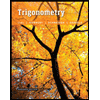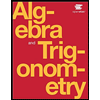(2, y) a = 60° Bシ170° (x, –1)
Trigonometry (11th Edition)
11th Edition
ISBN:9780134217437
Author:Margaret L. Lial, John Hornsby, David I. Schneider, Callie Daniels
Publisher:Margaret L. Lial, John Hornsby, David I. Schneider, Callie Daniels
Chapter1: Trigonometric Functions
Section: Chapter Questions
Problem 1RE:
1. Give the measures of the complement and the supplement of an angle measuring 35°.
Related questions
Question
Find the missing coordinate.

Transcribed Image Text:The image depicts a two-dimensional Cartesian coordinate system with two points and angles marked within. Here's a detailed transcription:
1. **Coordinate Plane**:
- The diagram shows a standard Cartesian coordinate system with x-axis and y-axis intersecting at the origin (0, 0).
2. **Points**:
- There are two labeled points:
- Point \( (x, -1) \) is located in the third quadrant.
- Point \( (2, y) \) is located in the first quadrant.
3. **Vectors and Angles**:
- Two vectors emanate from the origin, connecting to the two points.
- There is an angle \(\alpha = 60^\circ\) in green, formed between the positive x-axis and the vector leading to \( (2, y) \).
- There is also an angle \(\beta = 170^\circ\) in red, formed between the negative x-axis and the vector leading to \( (x, -1) \).
This diagram illustrates the use of angles in determining the direction of vectors in a coordinate plane. Understanding these concepts is crucial in fields such as physics, engineering, and computer graphics.
Expert Solution
This question has been solved!
Explore an expertly crafted, step-by-step solution for a thorough understanding of key concepts.
Step by step
Solved in 2 steps with 1 images

Knowledge Booster
Learn more about
Need a deep-dive on the concept behind this application? Look no further. Learn more about this topic, trigonometry and related others by exploring similar questions and additional content below.Recommended textbooks for you

Trigonometry (11th Edition)
Trigonometry
ISBN:
9780134217437
Author:
Margaret L. Lial, John Hornsby, David I. Schneider, Callie Daniels
Publisher:
PEARSON

Trigonometry (MindTap Course List)
Trigonometry
ISBN:
9781305652224
Author:
Charles P. McKeague, Mark D. Turner
Publisher:
Cengage Learning


Trigonometry (11th Edition)
Trigonometry
ISBN:
9780134217437
Author:
Margaret L. Lial, John Hornsby, David I. Schneider, Callie Daniels
Publisher:
PEARSON

Trigonometry (MindTap Course List)
Trigonometry
ISBN:
9781305652224
Author:
Charles P. McKeague, Mark D. Turner
Publisher:
Cengage Learning


Trigonometry (MindTap Course List)
Trigonometry
ISBN:
9781337278461
Author:
Ron Larson
Publisher:
Cengage Learning